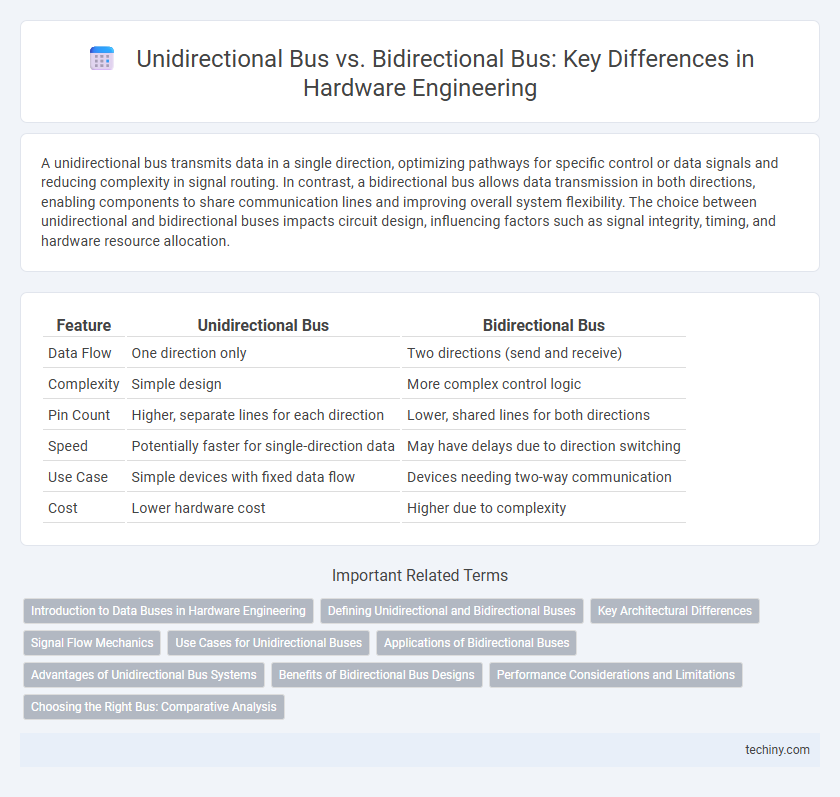A unidirectional bus transmits data in a single direction, optimizing pathways for specific control or data signals and reducing complexity in signal routing. In contrast, a bidirectional bus allows data transmission in both directions, enabling components to share communication lines and improving overall system flexibility. The choice between unidirectional and bidirectional buses impacts circuit design, influencing factors such as signal integrity, timing, and hardware resource allocation.
Table of Comparison
| Feature | Unidirectional Bus | Bidirectional Bus |
|---|---|---|
| Data Flow | One direction only | Two directions (send and receive) |
| Complexity | Simple design | More complex control logic |
| Pin Count | Higher, separate lines for each direction | Lower, shared lines for both directions |
| Speed | Potentially faster for single-direction data | May have delays due to direction switching |
| Use Case | Simple devices with fixed data flow | Devices needing two-way communication |
| Cost | Lower hardware cost | Higher due to complexity |
Introduction to Data Buses in Hardware Engineering
Data buses in hardware engineering serve as critical pathways for transferring binary data between components, where unidirectional buses allow data flow in a single direction from one device to another, optimizing simplicity and speed in specific applications. In contrast, bidirectional buses support data transmission in both directions on the same set of lines, enhancing communication efficiency and reducing pin count in complex systems. Selecting between unidirectional and bidirectional buses depends on factors like system complexity, data transfer requirements, and hardware design constraints.
Defining Unidirectional and Bidirectional Buses
A unidirectional bus transmits data flow in a single direction between components, enhancing simplicity and reducing signal interference in hardware design. In contrast, a bidirectional bus supports data transmission in both directions, enabling more flexible communication and resource sharing across hardware modules. Understanding the differences in data flow and control signals between unidirectional and bidirectional buses is essential for optimizing system architecture and performance in embedded systems and microprocessor design.
Key Architectural Differences
A unidirectional bus transfers data exclusively in one direction, simplifying control logic and reducing bus contention, but requiring separate lines for sending and receiving signals. In contrast, a bidirectional bus supports data flow in both directions on the same lines, optimizing pin count and wiring complexity while necessitating multiplexing and more sophisticated control mechanisms to avoid collisions. The choice between unidirectional and bidirectional buses impacts system design in terms of signal integrity, latency, and hardware resource allocation.
Signal Flow Mechanics
A unidirectional bus allows signals to flow in a single direction between components, simplifying control logic and reducing the risk of signal contention on the data lines. Bidirectional buses enable data transmission in both directions, facilitating more flexible communication but requiring complex bus arbitration and control mechanisms to manage signal direction changes. Signal flow mechanics in bidirectional buses rely on tri-state buffers or multiplexers that isolate transmitters to prevent conflicts, whereas unidirectional buses maintain a fixed signal flow path that eliminates the need for such control circuitry.
Use Cases for Unidirectional Buses
Unidirectional buses are ideal for simple data flow applications such as memory-to-processor communication, where signals only travel in one direction, ensuring minimal signal interference and easier timing control. They are commonly used in address buses and control signal lines to simplify circuit design and enhance reliability. This unidirectional nature provides a clearer path for data transfer, reducing the complexity of hardware logic compared to bidirectional buses.
Applications of Bidirectional Buses
Bidirectional buses are essential in hardware engineering for applications requiring two-way data communication, such as memory modules and microprocessor interfaces. These buses enable efficient data transfer by allowing multiple devices to transmit and receive signals on a shared communication line, reducing wiring complexity and cost. Common implementations include system buses in CPUs, I/O ports, and data buses in peripheral devices, where dynamic direction control optimizes performance and resource utilization.
Advantages of Unidirectional Bus Systems
Unidirectional bus systems offer simplified circuit design and reduced signal interference due to their straightforward data flow in a single direction. This architecture enhances timing reliability and minimizes the complexity of control logic, resulting in faster data transfer rates. Additionally, unidirectional buses improve system stability and ease troubleshooting, making them ideal for applications requiring predictable and consistent communication paths.
Benefits of Bidirectional Bus Designs
Bidirectional bus designs enhance data transfer efficiency by allowing signals to travel in both directions, reducing the number of required physical lines compared to unidirectional buses. This compact design lowers hardware complexity and cost while increasing system flexibility, enabling devices to communicate seamlessly without dedicated send and receive channels. The improved signal routing also supports higher throughput and simplifies circuit board layouts in advanced hardware engineering applications.
Performance Considerations and Limitations
Unidirectional buses offer simpler design and faster data transfer rates in one direction but suffer from underutilization and increased pin count for separate data and control lines. Bidirectional buses reduce pin requirements and enable data flow in both directions, enhancing flexibility, yet may experience lower maximum throughput due to bus contention and the need for direction control circuitry. Performance limitations of bidirectional buses include increased latency from bus arbitration and potential conflicts in multi-master environments, while unidirectional buses avoid these but at the cost of less efficient utilization of bus lines.
Choosing the Right Bus: Comparative Analysis
A unidirectional bus transfers data in a single direction, ideal for simple, dedicated communication paths with minimal control complexity, while a bidirectional bus enables data flow both ways, enhancing flexibility and reducing wiring but requiring more complex control logic. Choosing the right bus depends on system requirements such as data flow patterns, speed, and hardware constraints; unidirectional buses suit fixed data pathways, whereas bidirectional buses optimize hardware resource usage in systems with dynamic communication. Performance trade-offs between throughput and control overhead must be evaluated to determine the optimal bus architecture for efficient hardware design.
unidirectional bus vs bidirectional bus Infographic

 techiny.com
techiny.com